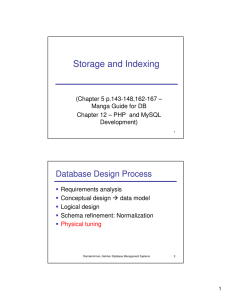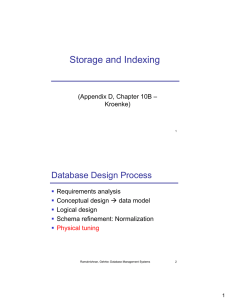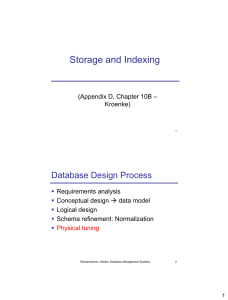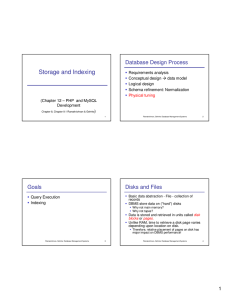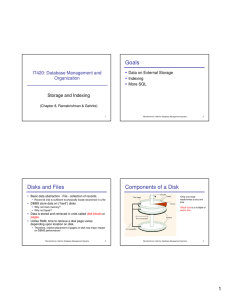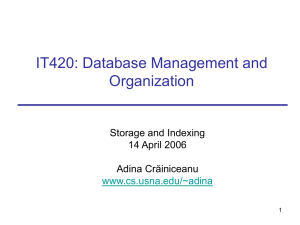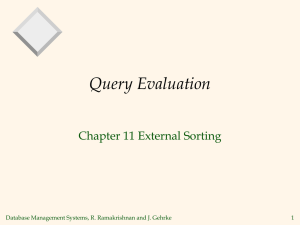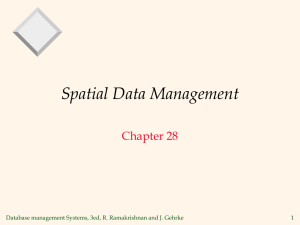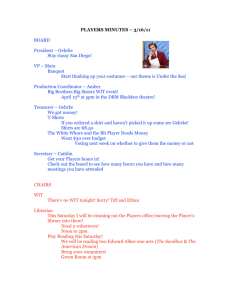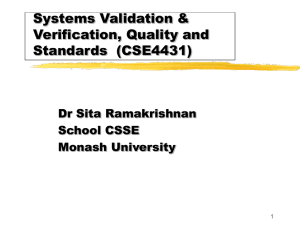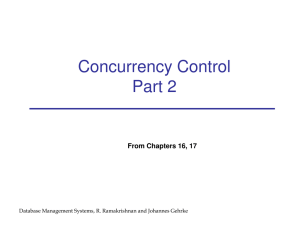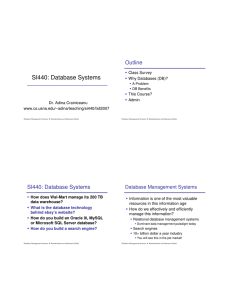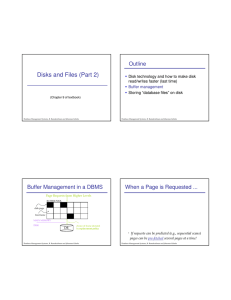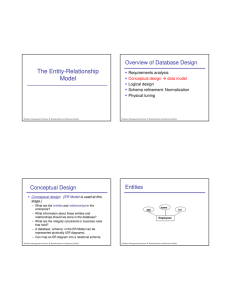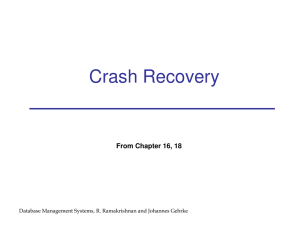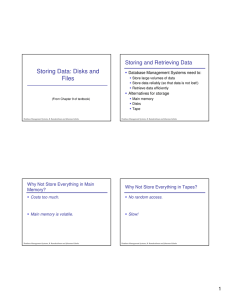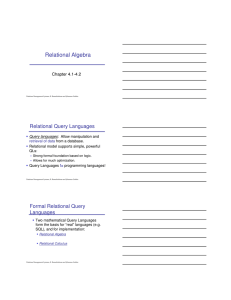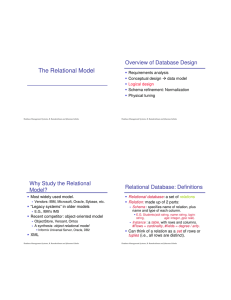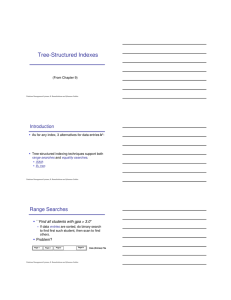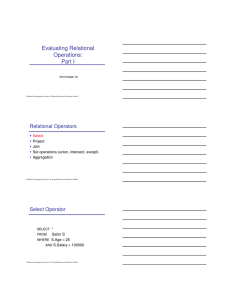Storage and Indexing Database Design Process
advertisement
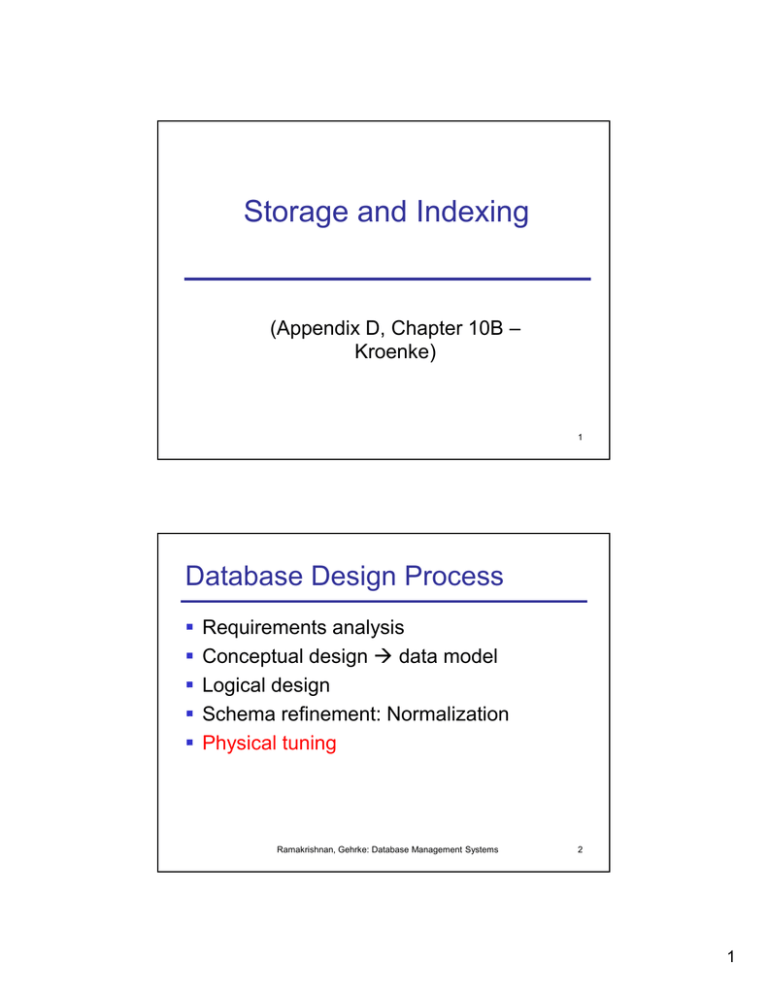
Storage and Indexing (Appendix D, Chapter 10B – Kroenke) 1 Database Design Process Requirements analysis Conceptual design data model Logical design Schema refinement: Normalization Physical tuning Ramakrishnan, Gehrke: Database Management Systems 2 1 Goals Query Execution Indexing Ramakrishnan, Gehrke: Database Management Systems 3 Disks and Files Basic data abstraction - File - collection of records DBMS store data on (“hard”) disks Why not main memory? Why not tapes? Data is stored and retrieved in units called disk blocks or pages. Unlike RAM, time to retrieve a disk page varies depending upon location on disk. Therefore, relative placement of pages on disk has major impact on DBMS performance! Ramakrishnan, Gehrke: Database Management Systems 4 2 Queries Equality queries: SELECT * FROM Product WHERE BarCode = 10002121 Range queries: SELECT * FROM Product WHERE Price BETWEEN 5 and 15 Assume: 200,000 rows in table – 20000 pages on disk Need indexes to allow fast access to data Ramakrishnan, Gehrke: Database Management Systems 5 Indexes An index on a file speeds up selections on the search key columns Any subset of the columns of a table can be the search key for an index on the table Ramakrishnan, Gehrke: Database Management Systems 6 3 Hash Index Constant search time Equality queries only Ramakrishnan, Gehrke: Database Management Systems 7 B+ Tree Index O(logdN) search time d – fan-out (~150) N – number of data entries Supports range queries Ramakrishnan, Gehrke: Database Management Systems 8 4 Example B+ Tree Find 28*? 29*? All > 15* and < 30* Insert/delete: Find data entry in leaf, then change it. Need to adjust parent sometimes. Change sometimes bubbles up the tree Ramakrishnan, Gehrke: Database Management Systems 9 Index Classification Clustered vs. unclustered: If order of rows on hard-disk is the same as order of data entries, then called clustered index. A file can be clustered on at most one search key. Cost of retrieving data records through index varies greatly based on whether index is clustered or not! Ramakrishnan, Gehrke: Database Management Systems 10 5 Clustered vs. Unclustered Ramakrishnan, Gehrke: Database Management Systems 11 Class Exercise Consider a disk with average I/O time 20msec and page size = 1024 bytes Table: 200,000 rows of 100 bytes each, no row spans 2 pages Find: Number of pages needed to store the table Time to read all rows sequentially Time to read all rows in some random order Ramakrishnan, Gehrke: Database Management Systems 12 6 CREATE INDEX in MySQL CREATE [UNIQUE] INDEX index_name [USING index_type] ON tbl_name (col_name,...) index_type BTREE | HASH Example: CREATE INDEX I_ItemPrice USING BTREE ON Items (Price) SELECT * FROM Product WHERE Price between 5 and 10 SELECT * FROM Product WHERE BarCode = 100111 Ramakrishnan, Gehrke: Database Management Systems 13 Indexes in SQL Server Only B+-tree index CREATE [UNIQUE] [CLUSTERED | NONCLUSTERED] index_name ON table_name (column1 [ASC|DESC] [, column2 …]) DROP INDEX index_name ON table_name Ramakrishnan, Gehrke: Database Management Systems 14 7 Use Indexes – Decisions to Make What indexes should we create? Which tables should have indexes? What column(s) should be the search key? Should we build several indexes? For each index, what kind of an index should it be? Clustered? Hash/tree? Ramakrishnan, Gehrke: Database Management Systems 15 Index Selection Guidelines Columns in WHERE clause are candidates for index keys. Exact match condition suggests hash index. Range query suggests tree index. Try to choose indexes that benefit as many queries as possible. At most one clustered index per table! Think of trade-offs before creating an index! Ramakrishnan, Gehrke: Database Management Systems 16 8 Examples Ramakrishnan, Gehrke: Database Management Systems 17 Class Exercise What index would you construct? 1. SELECT * FROM Mids WHERE Company = 6 2. SELECT CourseID, Count(*) FROM StudentsEnroll WHERE Company = 6 GROUP BY CourseID Ramakrishnan, Gehrke: Database Management Systems 18 9 Summary Indexes are used to speed up queries They can slow down inserts/deletes/updates Can have several indexes on a given table, each with a different search key. Indexes can be Hash-based vs. Tree-based Clustered vs. unclustered Ramakrishnan, Gehrke: Database Management Systems 19 10
